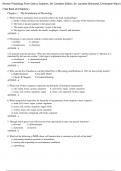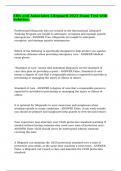(Human Physiology From Cells to Systems, 5th Canadian Edition, 5e Lauralee Sherwood, Christopher Ward )
(Test Bank all Chapters )
Chapter 1 – The Foundation of Physiology
1. Which of these statements most accurately reflects the study of physiology?
a. Stroke volume and heart rate determine cardiac output, which is a measure of the function of the heart.
b. The brain is located superior to the spinal cord.
c. The major organ of the respiratory system is the lung.
d. The digestive tract includes the mouth, esophagus, stomach, and intestines.
ANSWER: a
2. Physiology is most closely related to which other scientific discipline?
a. biology b. anatomy
c. biochemistry d. chemistry
ANSWER: b
3. If someone asks the question, “Why does the stomach secrete digestive juices?” and the response is “Because it is
stimulated by the nervous system,” what type of explanation does the response represent?
a. teleological b. phenomenological
c. mechanistic d. anatomical
ANSWER: c
4. Who was the first Canadian to win the Nobel Prize in Physiology and Medicine in 1923 for discovering insulin?
a. Ralph Steinman b. David H. Hubel
c. Charles B. Huggins d. Frederick Banting
ANSWER: d
5. Which one of these sequences represents the hierarchy of biological organization?
a. cell, organ, tissue, system, organism b. cell, tissue, organ, system, organism
c. tissue, cell, system, organism, organ d. tissue, cell, organism, system, organ
ANSWER: b
6. Which progression represents the hierarchy of organization, from simplest to most complex?
a. atom, cell, tissue, organ, system, organism
b. tissue, cell, system, organism, organ, body
c. system, atom, cell, organ, tissue, organism
d. atom, molecule, compound, cell, body, organism
ANSWER: a
7. Through which process do cells become more specialized to carry out specific functions?
a. division b. differentiation
c. maturation d. meiosis
ANSWER: b
8. Which of the following is NOT a basic cell function that is common to all cells of the body?
a. performing chemical reactions of metabolism
b. sensing and responding to environmental conditions
c. reproducing
Copyright Cengage Learning. Powered by Cognero. Page 1
,Name: Class: Date:
Chapter 1 – The Foundation of Physiology
d. synthesizing proteins
ANSWER: c
9. What type of tissue has cells that are specialized to generate force?
a. connective b. muscle
c. bone d. nervous
ANSWER: b
10. What type of tissue has cells that are specialized for sending messages over long distances?
a. connective b. muscle
c. bone d. nervous
ANSWER: d
11. Epithelial tissue is organized into which of the two general types of structures?
a. epithelial sheets and secretory glands b. cells and cell walls
c. ducts and nuclei d. protective and absorptive
ANSWER: a
12. Which of these statements is characteristic of connective tissue?
a. It has relatively few cells dispersed within an abundance of extracellular matrix.
b. It has no blood vessels.
c. It covers various parts of the body.
d. It is usually found in the walls of hollow cavities.
ANSWER: a
13. Which of the following is a type of connective tissue?
a. exocrine glands b. endocrine glands
c. blood d. smooth muscle tissue
ANSWER: c
14. What are the secretions of endocrine glands called?
a. paracrines b. autocrines
c. lumens d. hormones
ANSWER: d
15. Which of the following are two examples of exocrine glands?
a. sweat glands and glands that secrete digestive juices
b. mammary glands and pancreas
c. bladder and kidneys
d. thyroid gland and sweat glands
ANSWER: a
16. Which of these statements describes endocrine glands?
a. They consist of ducts.
Copyright Cengage Learning. Powered by Cognero. Page 2
,Name: Class: Date:
Chapter 1 – The Foundation of Physiology
b. They secrete hormones internally into the blood capillaries.
c. They are derived from connective tissue.
d. They include the salivary glands.
ANSWER: b
17. Which of these statements best describes an organ?
a. a collection of cells that collectively carry out a body function
b. a group of separate body structures that perform similar function, but come together to carry out activities that
are vital for survival
c. a structure made up of two or more different types of primary tissue that work together to perform a function
for the body
d. a structure that the body could not survive without
ANSWER: c
18. Why do most cells depend on other cells of the body for survival?
a. because cells do not contain fluid
b. because all cells of the body are physically connected with one another
c. because body cells cannot perform all life-sustaining functions on their own
d. because most cells of the body do not directly interact with the external environment and therefore need other
cells to provide nutrients and remove wastes
ANSWER: d
19. Which of these statements describes the internal environment?
a. It consists of intracellular fluid.
b. It is in direct contact with the body’s cells and consists of the extracellular fluid.
c. It is inside the body but not in direct contact with the body’s cells.
d. It is outside the body and keeps the fluid volume in unchanging composition.
ANSWER: b
20. What type of fluid resides within cells?
a. intracellular b. interstitial
c. extracellular d. plasma
ANSWER: a
21. What type of fluid is the fluid component of blood?
a. intracellular b. interstitial
c. extracellular d. plasma
ANSWER: d
22. What type of fluid is specifically refers to the fluid that is between neighbouring cells?
a. intracellular b. interstitial
c. extracellular d. plasma
ANSWER: b
23. Which of these statements describes extracellular fluid?
Copyright Cengage Learning. Powered by Cognero. Page 3
, Name: Class: Date:
Chapter 1 – The Foundation of Physiology
a. It is the external environment of the body. b. It is the fluid inside each cell.
c. It consists of plasma only. d. It consists of plasma and interstitial fluid.
ANSWER: d
24. Which of these statements applies to homeostasis?
a. It is a fixed state.
b. It is only required for certain cells of the body to survive.
c. Changes occur, but deviations from a set point are minimized.
d. Only factors external to the body are capable of triggering responses designed to maintain homeostasis.
ANSWER: c
25. Which of these factors is NOT under homeostatic regulation?
a. sweat rate
b. body temperature
c. levels of waste products in the body
d. levels of oxygen and carbon dioxide in the blood
ANSWER: a
26. Which of these statements applies to the integumentary system?
a. It eliminates unwanted substances from the body to the external environment.
b. It consists of the heart, blood vessels, and lungs in the pulmonary cavity.
c. It is important for protection of the body and also participates in temperature regulation.
d. It is responsible for taking up required essential nutrients for the body.
ANSWER: c
27. In which body system would you find the source of all the different types of blood cells?
a. endocrine system b. integumentary system
c. muscular system d. skeletal system
ANSWER: d
28. Which of these statements describes negative feedback?
a. A change in a regulated variable triggers a response by the effector that opposes the change.
b. The input to a system increases the output, and the output limits its own production by inhibiting the input.
c. A control system’s input and output continue to enhance each other in order to maintain homeostasis.
d. It is the main operating principle of most of the body’s homeostatic control mechanisms.
ANSWER: b
29. What are the two systems concerned with the control of body functioning by extrinsic controls?
a. nervous and respiratory b. nervous and endocrine
c. endocrine and respiratory d. endocrine and lymphatic
ANSWER: b
30. In a negative-feedback loop, which component compares the level of a variable to its set point level?
a. receptor b. control centre
Copyright Cengage Learning. Powered by Cognero. Page 4





